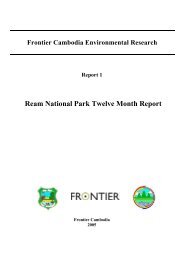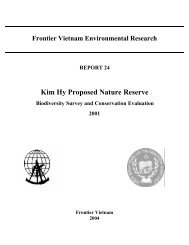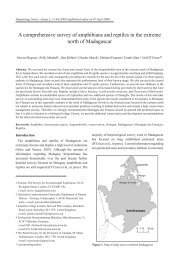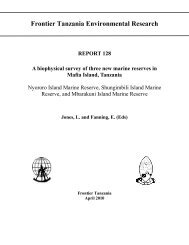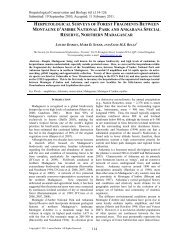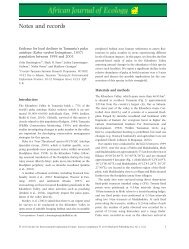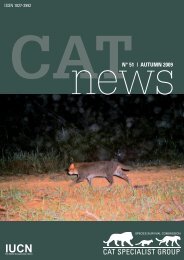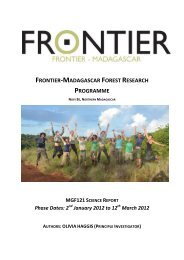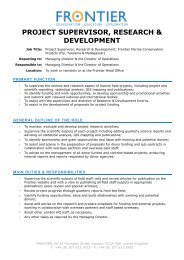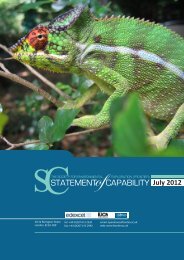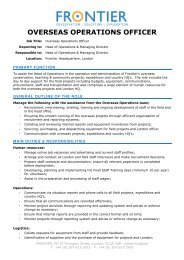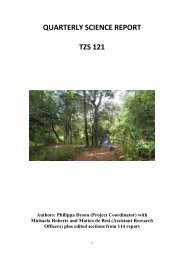An assessment of local fisheries in Diego-Suarez Bay, Madagascar
An assessment of local fisheries in Diego-Suarez Bay, Madagascar
An assessment of local fisheries in Diego-Suarez Bay, Madagascar
You also want an ePaper? Increase the reach of your titles
YUMPU automatically turns print PDFs into web optimized ePapers that Google loves.
would be a viable management option if the excursions were controlled and any environmental impacts<br />
from an <strong>in</strong>crease <strong>in</strong> tourism were considered and avoided. Further <strong>in</strong>vestigation would have to be<br />
conducted to assess whether the current number <strong>of</strong> tourists visit<strong>in</strong>g Ramena would be enough to support<br />
an <strong>in</strong>creased number <strong>of</strong> tour guides.<br />
Fish<strong>in</strong>g was considered to have an impact on the environment by the greater part <strong>of</strong> fishermen<br />
<strong>in</strong>terviewed. Impacts witnessed dur<strong>in</strong>g LIT and UVC surveys <strong>in</strong>cluded; discarded nets attached to coral<br />
colonies, particularly branch<strong>in</strong>g and foliose species and <strong>in</strong> some cases cover<strong>in</strong>g about 5m <strong>of</strong> coral,<br />
discarded fish<strong>in</strong>g hook and l<strong>in</strong>e, <strong>in</strong>clud<strong>in</strong>g one <strong>in</strong>cident <strong>of</strong> ghost fish<strong>in</strong>g and anchor damage to hard and<br />
s<strong>of</strong>t corals. Most <strong>of</strong> the study sites exhibited some visible impact to fish<strong>in</strong>g. Education through workshops<br />
provid<strong>in</strong>g <strong>in</strong>formation on how to reduce impacts would be a simple management plan to reduce damage.<br />
Local Malagasy people observe fadys, which are acts <strong>of</strong> taboo or banned activities due to superstitious<br />
beliefs. Many fishermen consider there to be fadys associated with fish<strong>in</strong>g. There are a number <strong>of</strong> <strong>local</strong><br />
fadys described by the fishermen which would fit <strong>in</strong> well with management schemes e.g. no fish<strong>in</strong>g at<br />
night, not us<strong>in</strong>g lights at night, no bang<strong>in</strong>g the water, no fish<strong>in</strong>g on Tuesdays, Thursdays and Sundays,<br />
and not us<strong>in</strong>g metal <strong>in</strong> the water. These <strong>local</strong> customs could be comb<strong>in</strong>ed with other management<br />
schemes to provide a management plan that is considered acceptable by all <strong>local</strong> people.<br />
The questionnaire results provide an <strong>in</strong>terest<strong>in</strong>g <strong>in</strong>sight <strong>in</strong>to the op<strong>in</strong>ions <strong>of</strong> the fishermen. As with the use<br />
<strong>of</strong> questionnaires <strong>in</strong> general <strong>in</strong> scientific <strong>in</strong>vestigations there is always an element <strong>of</strong> the <strong>in</strong>terviewee<br />
say<strong>in</strong>g th<strong>in</strong>gs to please the <strong>in</strong>tervie wer. Due to the questionnaires be<strong>in</strong>g conducted through an <strong>in</strong>terpreter<br />
it is difficult <strong>in</strong> this case to determ<strong>in</strong>e whether the <strong>in</strong>terviewees were say<strong>in</strong>g this they considered the<br />
<strong>in</strong>terviewers wanted to hear. However each <strong>in</strong>terview was done separately to prevent the <strong>in</strong>terviewee<br />
hav<strong>in</strong>g their answers be<strong>in</strong>g <strong>in</strong>fluenced by others. The fishermen <strong>in</strong>terviewed were very welcom<strong>in</strong>g, were<br />
not distrust<strong>in</strong>g <strong>of</strong> the questionnaire process and thus we feel that the results are unbiased.<br />
4.2 Resource status (UVC and LIT) and visual observations<br />
A number <strong>of</strong> relationships were tested to determ<strong>in</strong>e if there is a pattern <strong>in</strong> the biological value <strong>of</strong> sectors<br />
and the presence <strong>of</strong> fishermen. No association was found between hard coral cover and number <strong>of</strong> fish<strong>in</strong>g<br />
vessels (figure 8), fish species richness vs. number <strong>of</strong> fish<strong>in</strong>g vessels and mean number <strong>of</strong> fish counted vs.<br />
number <strong>of</strong> fish<strong>in</strong>g vessels. There was however an association between mean fish biomass vs. number <strong>of</strong><br />
fish<strong>in</strong>g vessels (figure 9). Fishermen appear not to be visit<strong>in</strong>g areas where there is high coral cover, high<br />
fish species richness and high fish counts for their chosen areas to fish. Fishermen are fish<strong>in</strong>g areas where<br />
they know there to be a large biomass <strong>of</strong> fish. How they know this is likely to be through knowledge<br />
passed down from generation on where to f<strong>in</strong>d the largest resident fish or where to follow seasonal<br />
migrations <strong>of</strong> reef associated fish. Personal experience and observations over many years <strong>of</strong> fish<strong>in</strong>g would<br />
also give them the knowledge on where best to fish.<br />
The mean size <strong>of</strong> fish found <strong>in</strong> the bay regardless <strong>of</strong> species shows that there is a dist<strong>in</strong>ct lack <strong>of</strong> fish<br />
larger than 30cm <strong>in</strong> length (figure 10). Fish<strong>in</strong>g pressure is likely to have caused this, as all <strong>of</strong> the reefs <strong>in</strong><br />
the bay are easily accessible, fr<strong>in</strong>g<strong>in</strong>g reefs. Be<strong>in</strong>g able to compare fish size with <strong>of</strong>fshore reefs or barrier<br />
reefs (such as <strong>in</strong> Nosy Be, northwest <strong>Madagascar</strong>) that are more difficult to access could prove that<br />
fish<strong>in</strong>g pressure is the cause <strong>of</strong> a reduced numbers <strong>of</strong> fish >30cm and not any other anthropogenic or<br />
physical factors. The fact that fishermen are able to travel relatively short distances, fish and then camp<br />
on the nearby shore, allows them more time to fish compared to fish<strong>in</strong>g <strong>in</strong> the open sea and return<strong>in</strong>g to<br />
land each day. It also allows them to move to a different area if they are not hav<strong>in</strong>g success. This means<br />
areas can be fished by different fishermen several times a day, <strong>in</strong>creas<strong>in</strong>g fish<strong>in</strong>g pressure. The ease <strong>of</strong><br />
access <strong>of</strong> these reefs could be a confound<strong>in</strong>g reason to the high and cont<strong>in</strong>uous fish<strong>in</strong>g pressure.<br />
Investigat<strong>in</strong>g the differences <strong>in</strong> size distributions <strong>in</strong> areas that have no fish<strong>in</strong>g pressure with areas hav<strong>in</strong>g<br />
vary<strong>in</strong>g degrees <strong>of</strong> fish<strong>in</strong>g pressure to identify if fish<strong>in</strong>g has an impact or not, would be a key l<strong>in</strong>e <strong>of</strong><br />
enquiry for the future. Tak<strong>in</strong>g <strong>in</strong>to account access to a fish<strong>in</strong>g area, reef quality and other environmental<br />
factors such as exposure and levels <strong>of</strong> sedimentation would help to provide accurate results.<br />
19



